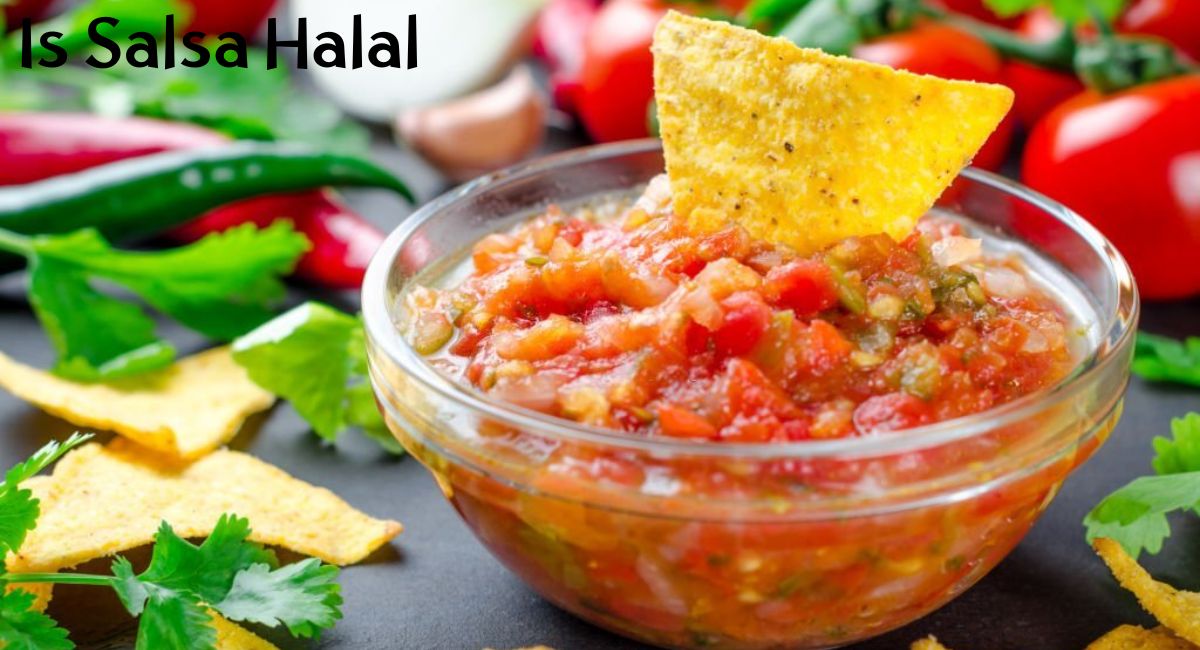Salsa, a popular and vibrant condiment in the world of cuisine, has captured the taste buds of people across the globe with its zesty and flavorful profile. However, for individuals adhering to specific dietary guidelines, such as those prescribed by Islam, questions may arise about the halal status of salsa.
In this discussion, we will delve into the ingredients commonly used in salsa preparation and explore whether this beloved sauce aligns with the principles of halal consumption. Understanding the components of salsa and the considerations for halal dietary practices can help Muslim individuals make informed choices when enjoying this delectable addition to their meals.
Is Salsa Halal
Salsa, in its basic form, is typically considered halal, as it consists of ingredients like tomatoes, onions, peppers, cilantro, and various spices. These ingredients are generally permissible in Islamic dietary laws.
However, the halal status of salsa may depend on various factors:
- Ingredients: You should check the ingredients list on the salsa packaging to ensure that there are no haram (forbidden) ingredients. Some commercial salsas may contain additives, preservatives, or flavorings that could potentially be of concern.
- Alcohol: Some salsa recipes or commercial salsas may contain alcohol as a flavoring agent or preservative. In Islamic dietary laws, the consumption of alcohol is generally prohibited. Therefore, you should check the ingredient list to ensure there is no alcohol content.
- Cross-Contamination: If the salsa is prepared or processed in facilities that handle non-halal ingredients or utensils that have been used for non-halal foods, there is a risk of cross-contamination. It’s important to consider the production and handling practices to determine if the salsa remains halal.
- Homemade Salsa: When making homemade salsa, you have control over the ingredients and preparation process, making it easier to ensure that the salsa is halal.
According to Halalharam.org, the following Salsa sauces are halal.
| Brand | Product Name | Status |
|---|---|---|
| Stater Bros. | Mild Salsa | Halal |
| Senora Verde | Mild Salsa | Halal |
| Red Wing | Salsa Sauce – Hot | Halal |
| Red Wing | Salsa Sauce – Medium | Halal |
| Red Wing | Salsa Sauce – Mild | Halal |
| Paradise Products | Salsa Sauce | Halal |
| Ortega | Dipping Salsa – Hot | Halal |
| Ortega | Dipping Salsa – Medium | Halal |
| Ortega | Dipping Salsa – Mild | Halal |
| Ortega | Garden Style Salsa | Halal |
| Ortega | Green Chile Salsa – Hot | Halal |
| Ortega | Black Bean & Corn Salsa | Halal |
| Nabisco | Ortega Hot Green Chili Salsa | Halal |
| Nabisco | Ortega Mild Green Chili Salsa | Halal |
| Nabisco | Ortega Medium Green Chili Salsa | Halal |
| My Essentials | Mild Salsa | Halal |
| My Essentials | Hot Salsa | Halal |
| Le Jardin | Mild Salsa | Halal |
| Krasdale | Hot Salsa | Halal |
| Hotcha | Cha-Cha Salsa | Halal |
| Esplendido | Thick and Chunky Salsa | Halal |
| Newman’s Own | All Natural Medium Salsa | Halal |
| Newman’s Own | All Natural Hot Salsa | Halal |
| Red Gold | Black Bean & Corn Salsa | Halal |
What is Salsa
Salsa sauce, often referred to simply as “salsa,” is a popular condiment and dip in Mexican cuisine, as well as in many other parts of the world. It has ancient origins, dating back to the Aztecs, Mayans, and other indigenous peoples of Mesoamerica. These civilizations were already preparing sauces made from tomatoes, chili peppers, and other local ingredients long before the arrival of Europeans in the Americas.
The tomato, a key ingredient in modern salsa, was introduced to Europe by Spanish explorers who brought it back from the New World. Tomatoes eventually made their way back to the Americas via trade routes, where they were incorporated into local cuisines.
Salsa, in its various forms, continued to evolve in Mexico. It was traditionally prepared using a stone mortar and pestle, which allowed for the crushing and mixing of ingredients. The word “salsa” itself comes from the Spanish word for “sauce.”
Different regions of Mexico developed their own unique salsa recipes, often reflecting the local ingredients and culinary traditions. For example, pico de gallo is a fresh salsa made with diced tomatoes, onions, and cilantro, while salsa verde is made with tomatillos and green chili peppers.
Salsa gained popularity beyond Mexico’s borders during the 20th century. Mexican immigrants in the United States and elsewhere played a significant role in popularizing salsa, leading to the creation of numerous commercial salsa brands. These salsas cater to various tastes, from mild to extremely spicy.
Modern salsa recipes can include a wide variety of ingredients, such as fruit, corn, beans, and more. Salsas can be mild, medium, or hot in terms of spiciness, depending on the type and amount of chili peppers used.
Types of Salsa
There are numerous types of salsa, each with its unique flavor profile and ingredients. Salsa recipes can vary widely based on regional influences, personal preferences, and the intended use of the salsa. Here are some popular types of salsa:
Pico de Gallo: Also known as salsa fresca or salsa cruda, pico de gallo is a fresh salsa made with diced tomatoes, onions, cilantro, jalapeño or serrano peppers, lime juice, and salt. It is typically mild and is often used as a topping for tacos, grilled meats, or as a dip for tortilla chips.
Salsa Roja: This is a red salsa made with cooked or roasted tomatoes, chili peppers (such as jalapeños or chipotles), onions, garlic, and various seasonings. It can vary in spiciness and is a common accompaniment for enchiladas, tamales, and grilled dishes.
Salsa Verde: Salsa verde is a green salsa made with tomatillos (green tomatoes), chili peppers, onions, cilantro, and lime juice. It has a tangy, slightly tart flavor and is used in dishes like enchiladas verdes and chilaquiles.
Mango Salsa: This fruity salsa is made with ripe mangoes, red onions, cilantro, lime juice, and sometimes chili peppers. It offers a sweet and spicy flavor profile and pairs well with grilled chicken, fish, or as a refreshing dip.
Corn Salsa: Corn salsa typically includes sweet corn kernels, bell peppers, onions, cilantro, lime juice, and sometimes black beans or other vegetables. It’s a popular choice for adding a sweet and crunchy element to dishes like burritos or tacos.
Habanero Salsa: Habanero salsa is known for its intense heat. It’s made with habanero chili peppers, tomatoes, onions, and garlic. Due to its spiciness, it’s used sparingly as a condiment or dip.
Salsa Negra: This dark, smoky salsa is made by frying dried chili peppers, garlic, and other seasonings until they’re charred and then blending them into a sauce. It’s commonly used in Mexican cuisine, particularly with grilled meats.
Chipotle Salsa: Chipotle salsa is made with smoked and dried chipotle peppers, tomatoes, onions, and garlic. It has a smoky and spicy flavor and is often used as a condiment for tacos, burritos, and grilled meats.
Salsa Ranchera: Salsa ranchera is a tomato-based salsa that includes ingredients like onions, garlic, chili peppers, and spices. It’s simmered until it thickens and is often used in Mexican breakfast dishes like huevos rancheros.
Fruit Salsas: In addition to mango salsa, you can find various fruit salsas made with ingredients like pineapple, papaya, or strawberries. These salsas add a sweet and refreshing twist to traditional salsas.
These are just a few examples of the many types of salsa available. Salsas can be adapted and customized to suit individual tastes and preferences, making them a versatile and flavorful addition to a wide range of dishes.
Salsa Ingredients
Salsa is a versatile condiment, and its ingredients can vary widely depending on the type of salsa and personal preferences. However, here are some common ingredients often found in salsa recipes:
- Tomatoes: Tomatoes are a fundamental ingredient in many salsas. You can use ripe red tomatoes for red salsas and tomatillos (green tomatoes) for green salsas.
- Onions: Onions, typically red or white onions, are often used to add a sharp and savory flavor to salsa. They can be finely diced or sliced.
- Chili Peppers: Chili peppers provide the heat and spiciness in salsa. Common options include jalapeños, serranos, habaneros, or poblano peppers. The choice of pepper affects the salsa’s spiciness level.
- Cilantro: Fresh cilantro leaves and stems add a bright and herbaceous flavor to salsa. Some people love cilantro, while others find it polarizing; you can adjust the quantity to taste.
- Garlic: Minced or finely chopped garlic cloves can enhance the savory and aromatic qualities of salsa. Use it sparingly, as it can be quite potent.
- Lime or Lemon Juice: Citrus juice, typically from limes or lemons, adds acidity and brightness to salsa. It also helps balance the flavors and prevents the salsa from browning.
- Salt: Salt is a crucial seasoning in salsa, as it enhances the flavors of the other ingredients and helps meld them together.
- Cumin: Ground cumin is a common spice used in many salsa recipes, especially in tomato-based salsas. It provides earthy and warm notes.
- Sugar: Some salsas, especially fruit salsas, may include a small amount of sugar to enhance the sweetness of the ingredients.
- Vinegar: In some recipes, a splash of vinegar, such as white or apple cider vinegar, can be used to add tanginess and balance the flavors.
- Olive Oil: In certain variations of salsa, olive oil may be added for richness and a smoother texture.
- Corn: Corn kernels, either fresh or cooked, can be added to salsas for sweetness and texture.
- Black Beans: Salsas like cowboy caviar or corn and black bean salsa include black beans for added protein and a hearty texture.
- Fruit: Salsas with a fruity twist may contain ingredients like mangoes, pineapples, strawberries, or peaches to provide sweetness and contrast.
- Avocado: Avocado chunks or cubes can be added to create a creamy and rich texture in salsas like guacamole.
- Cayenne Pepper, Paprika, or Other Spices: These spices can be used to adjust the flavor and heat level of the salsa to your liking.
How is Salsa Made
Making salsa is relatively simple and can be done in various ways, depending on the type of salsa you want to create and your personal preferences. Here’s a basic method for making a classic tomato-based salsa, often referred to as pico de gallo or salsa fresca:
Ingredients:
- 4 ripe tomatoes, diced
- 1/2 to 1 onion (red or white), finely chopped
- 1 to 2 jalapeño or serrano peppers, finely chopped (adjust for desired spiciness)
- 1/2 cup fresh cilantro, chopped
- 2 cloves garlic, minced (optional)
- Juice of 1-2 limes
- Salt to taste
Instructions:
Prepare the Ingredients: Wash and dice the tomatoes. Remove the seeds and excess liquid to prevent the salsa from becoming too watery. Finely chop the onion. Finely chop the chili peppers. Remember that the seeds and membranes contain most of the heat, so adjust the spiciness by including or omitting them. Chop the fresh cilantro leaves and stems. If using garlic, mince it finely.
Combine the Ingredients: In a mixing bowl, combine the diced tomatoes, chopped onion, chopped chili peppers, minced garlic (if using), and chopped cilantro.
Add Lime Juice: Squeeze the juice of 1-2 limes over the ingredients in the bowl. Start with one lime, taste the salsa, and add more lime juice if needed for acidity and flavor.
Season with Salt: Sprinkle salt over the mixture, starting with a pinch. Taste the salsa and adjust the salt as necessary. Salt enhances the flavors and helps meld them together.
Mix Thoroughly: Gently mix all the ingredients together using a spoon or spatula. Be careful not to overmix, as you want to maintain the texture of the tomatoes and other ingredients.
Chill and Serve: Cover the salsa and refrigerate it for at least 30 minutes before serving. This allows the flavors to meld and develop. Some people prefer to serve salsa chilled, while others like it at room temperature.
Adjust as Needed: Taste the salsa before serving and adjust the seasoning, lime juice, or spiciness level if necessary. You can also add a little more cilantro if desired.
Serve: Serve the salsa with tortilla chips, as a topping for tacos, burritos, grilled meats, or alongside various Mexican dishes.
How to Use Salsa
Salsa is a versatile condiment that can be used in a variety of ways to enhance the flavor of your dishes. Here are some common ways to use salsa:
- Dip for Tortilla Chips: Salsa is a classic dip for tortilla chips. Simply scoop the salsa onto a chip and enjoy. You can serve it as a snack or appetizer at parties or gatherings.
- Taco Topping: Salsa is a popular topping for tacos, whether you’re making beef, chicken, fish, or vegetarian tacos. It adds a burst of freshness and flavor to your taco fillings.
- Burrito or Quesadilla Filling: Use salsa as a flavorful filling for burritos or quesadillas. It complements ingredients like beans, cheese, rice, and grilled meats.
- Nachos: Salsa is a key component of nachos. Pour it over a plate of tortilla chips, add melted cheese, and garnish with toppings like sour cream, guacamole, and jalapeños.
- Grilled Meats: Salsa can serve as a delicious accompaniment to grilled meats such as chicken, steak, or pork. Spoon it over the meat just before serving to add a burst of flavor.
- Eggs: Top your scrambled eggs or omelets with salsa for a zesty breakfast. Salsa can also be used in breakfast burritos or as a dip for breakfast tacos.
- Baked Potatoes: Salsa can be a tasty and healthier alternative to sour cream and butter as a topping for baked potatoes.
- Fish and Seafood: Salsa pairs well with grilled or baked fish and seafood. It adds a refreshing contrast to the richness of the seafood.
- Salads: Use salsa as a salad dressing or topping for a Southwestern or Mexican-inspired salad. It can replace traditional vinaigrettes and add extra flavor.
- Sides: Salsa can be served as a side dish alongside dishes like rice and beans, grilled vegetables, or black bean soup. It adds a burst of flavor and color to the meal.
- Marinades and Sauces: Salsa can be used as a base or component of marinades for meats or as a sauce for dishes like enchiladas, chicken fajitas, or tamales.
- Burgers and Sandwiches: Add a spoonful of salsa to your burgers or sandwiches for a unique flavor twist. It works well with both meat and vegetarian options.
- Salsa Verde for Enchiladas: Salsa verde is commonly used as a sauce for enchiladas. Pour it over rolled tortillas filled with ingredients like cheese, chicken, or beans, then bake until bubbly.
- Chips and Salsa Bar: When hosting a party or gathering, consider setting up a “chips and salsa bar” with various types of salsa, including mild, medium, and spicy varieties, along with a selection of tortilla chips and toppings for guests to customize their snacks.
- Fruit Salsa Dessert: Fruit salsa, often made with ingredients like mangoes or strawberries, can be served as a dessert topping for ice cream, cheesecake, or pound cake.
Searching for the halal certification of sauces with a spicy flavor profile akin to Salsa sauce? Check out these articles
Is Sriracha Halal: Uncover the spicy truth about everyone’s favorite hot sauce. Dive into this article to learn whether Sriracha sauce is permissible (halal) for consumption according to Islamic dietary guidelines.
Is Tabasco Halal: Explore the tangy world of Tabasco sauce and find out if it aligns with halal standards. This article delves into the ingredients and production process to determine whether Tabasco sauce is suitable for Muslim consumers.






